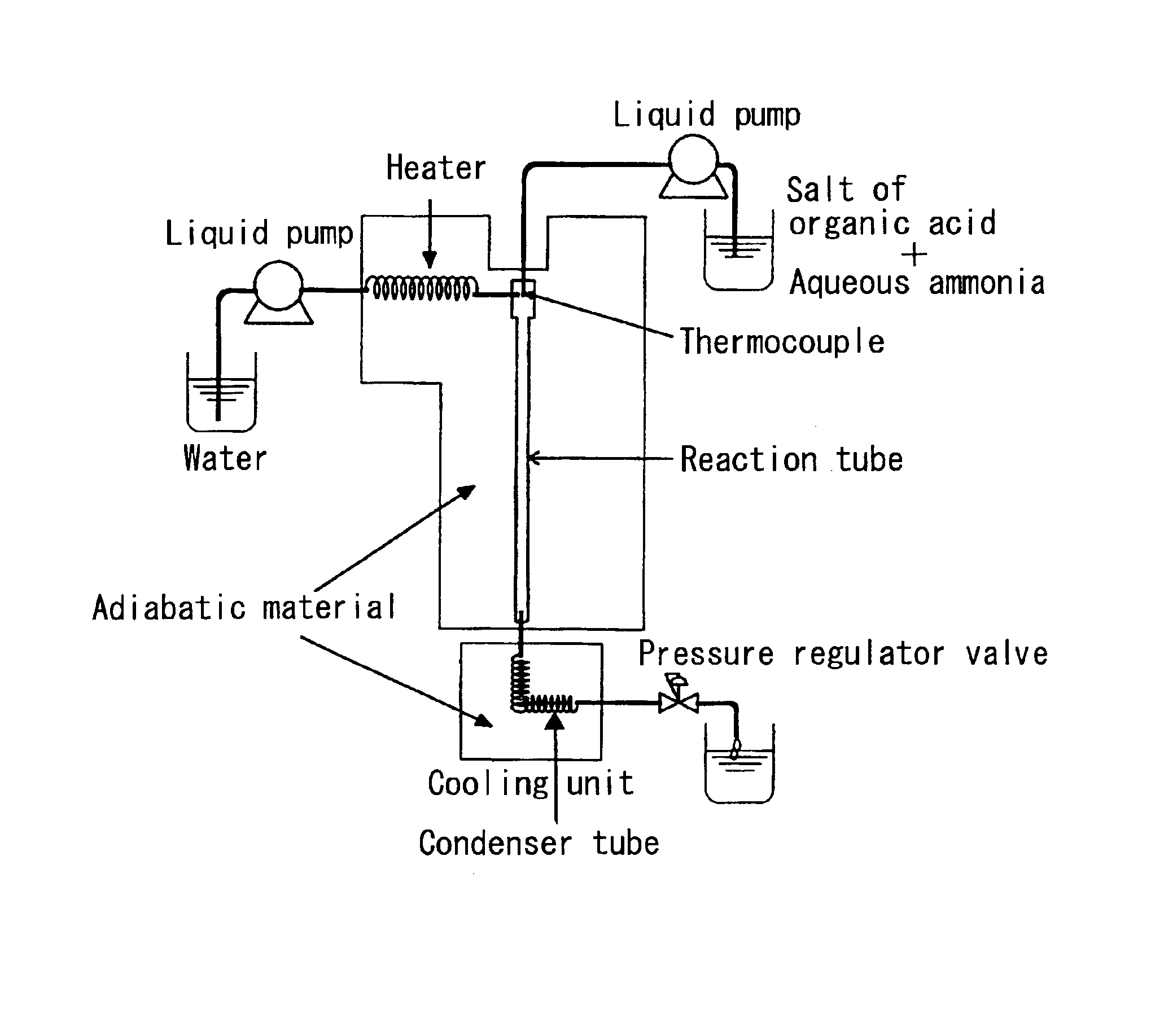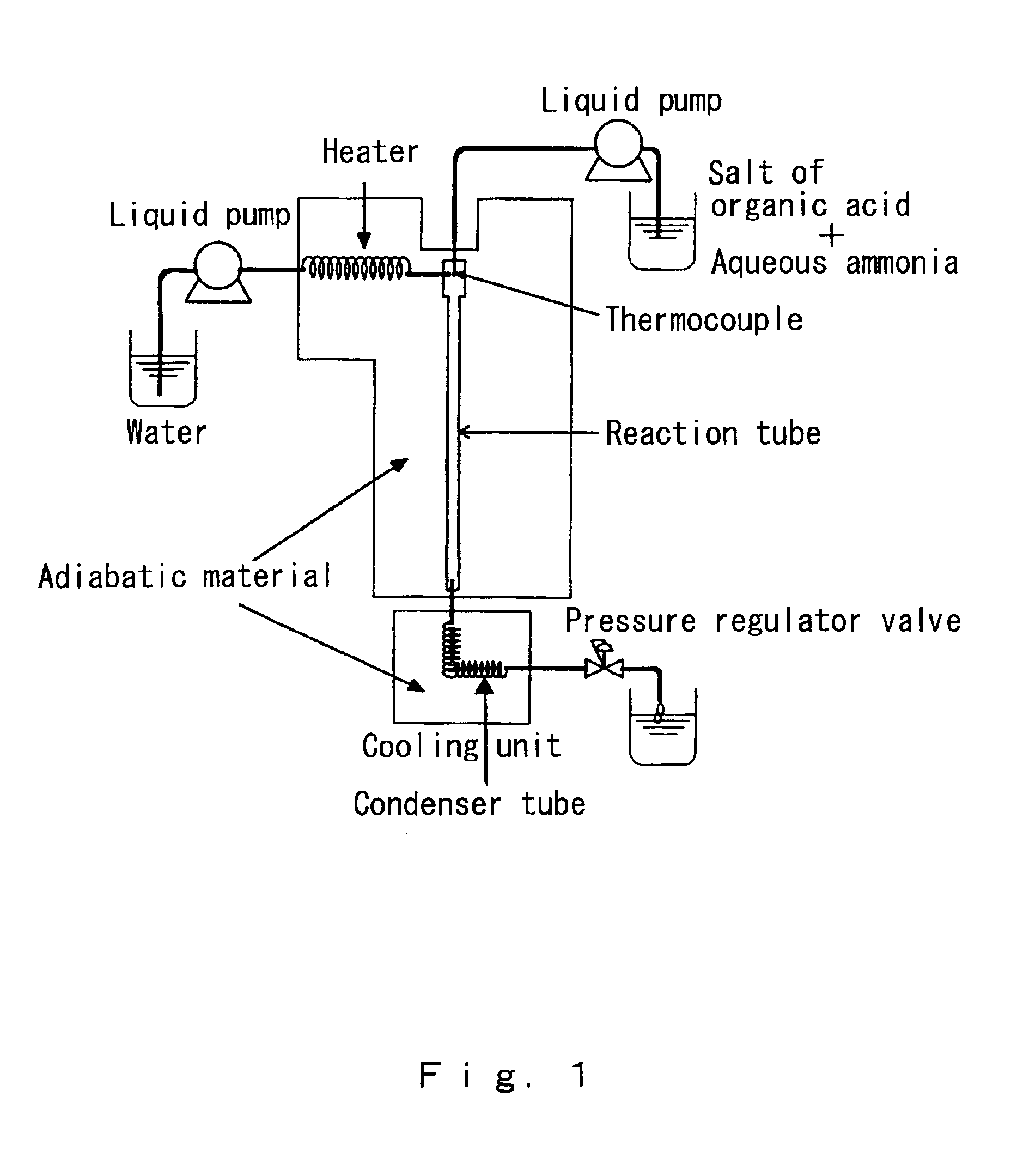Method of introducing amino group and method of synthesizing amino acid compound
- Summary
- Abstract
- Description
- Claims
- Application Information
AI Technical Summary
Benefits of technology
Problems solved by technology
Method used
Image
Examples
example 1
[0067]Using the continuous reaction apparatus shown in FIG. 1, sodium lactate (reagent made by Wako Pure Chemicals) and aqueous ammonia (reagent chemicals made by Wako Pure Chemicals) were reacted under high-temperature and high-pressure water conditions in which the temperature was 374° C., the pressure was 30 MPa, and the density was 0.558 g / cm3, to attempt the continuous synthesis of alanine by the introduction of amino groups.
[0068]The reactor was made from alloy C-276, the inside diameter of the reactor was 0.65 mm, and the reactor length was 25 cm. The reactor volume was therefore calculated to be 0.083 cm3. A high-pressure injection pump was used to introduce the various preparations. The water used in the reaction was distilled water, and carrier water from which dissolved oxygen had been purged by bubbling with nitrogen gas was sent through the system at a rate of 9.3 mL / min. Using similarly treated distilled water, a substrate solution containing 1.08 M sodium lactate and ...
example 2
[0069]Sodium lactate and aqueous ammonia were continuously reacted for one hour using the same continuous reaction apparatus as in Example 1 and under exactly the same conditions. The reaction solution thus obtained was passed through a cation exchange resin (50W-X8, made by Dow Chemical) column, which separated the produced alanine from the sodium lactate and lactic acid, and the alanine-containing solution was concentrated and refined, after which it was precipitated with ethanol, and the precipitate was filtered and dried to obtain 0.47 g of the product of the present invention. This product was in the form of a pure-white powder, and was confirmed from FTIR absorption spectrum measurement results and NMR measurement results to be high-purity alanine containing substantially no impurities.
example 3
[0070]The continuous synthesis of alanine from sodium lactate and aqueous ammonia was attempted by conducting the same reaction as in Example 1. Also, using the continuous reaction apparatus shown in FIG. 2, 1.08 M sodium lactate and 5 M ammonia aqueous solution that had each been separately prepared were injected into the reactor by two different water pumps. The reactor was made from alloy C-276, the inside diameter of the reactor was 0.65 mm, the reactor length was 25 cm, and the reactor volume was calculated to be 0.083 cm3. Each introduced preparation was injected at a different flux by a high-pressure pump, which allowed the concentration ratio to be controlled as desired.
[0071]Some of the reaction conditions, however, were changed as follows.
Changed Reaction Conditions
[0072]Reaction temperature: 383° C.
[0073]High-temperature and high-pressure water density:[0074]0.504 g / cm3
[0075]Carrier water flow rate: 10 mL / min
[0076]1.08 M sodium lactate aqueous solution flow rate:[0077]1....
PUM
| Property | Measurement | Unit |
|---|---|---|
| Temperature | aaaaa | aaaaa |
| Time | aaaaa | aaaaa |
| Time | aaaaa | aaaaa |
Abstract
Description
Claims
Application Information
 Login to View More
Login to View More - R&D
- Intellectual Property
- Life Sciences
- Materials
- Tech Scout
- Unparalleled Data Quality
- Higher Quality Content
- 60% Fewer Hallucinations
Browse by: Latest US Patents, China's latest patents, Technical Efficacy Thesaurus, Application Domain, Technology Topic, Popular Technical Reports.
© 2025 PatSnap. All rights reserved.Legal|Privacy policy|Modern Slavery Act Transparency Statement|Sitemap|About US| Contact US: help@patsnap.com



